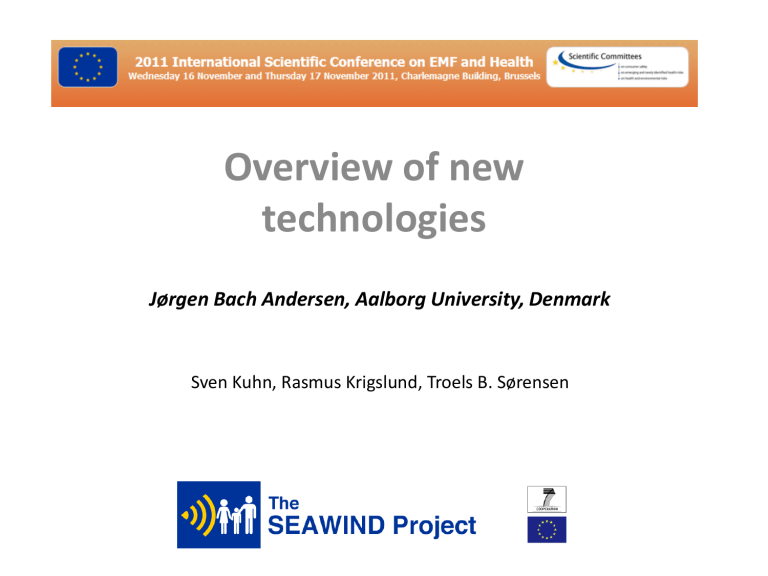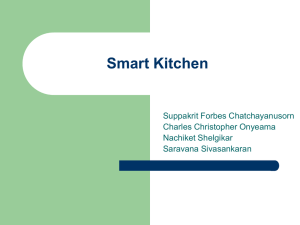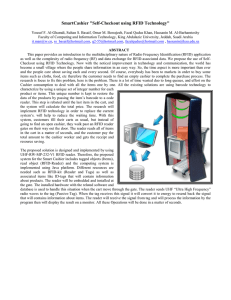EU 2011

Overview of new technologies
Jørgen Bach Andersen, Aalborg University, Denmark
Sven Kuhn, Rasmus Krigslund, Troels B. Sørensen
GSM + UMTS
GSM
Gausssian Minimum Shift Keying (GMSK)
Constant envelope modulation, all the information is in the phase
Time domain
Frequency domain
No higher frequencies in the case of GSM (except for EDGE)
WCDMA (UMTS) 3G
• multiple access is controlled by code division
• rapid power control at 1500 Hz
• non-constant envelope modulation
Uplink. Browsing with a handset
Chip rate
T=64 ms (0-5 kHz)
T=0.5 ms (0-4 MHz)
Measured spectrum from WCDMA base station
0-10 kHz 0-50 kHz
Note the dominant 15 kHz common pilot signal, different from the 1500
Hz power control component. Also a weak 100 Hz.
WCDMA (UMTS) 3G
By coding the signal is spread over a larger bandwidth with the consequence of having a processing gain equal to the bandwidth ratio.
For speech the gain is large, for high data rates it is small.
Rapid power control ensures low as possible transmit powers.
Handset transmit Handset receive
From Gati et al, Duality between uplink local and downlink whole-body exposures in operating networks, IEEE Transact EMC, 2010,52,no4,829-836
GSM
900
GSM
1800
3G
UMTS
LTE 3.9 G
‘Long Term Evolution’ system is the answer to high data rates, for
4G theoretically 1 Gb/s in downlink (from base to user).
It is basically different from 3G in access method and modulation. A flexible bandwidth scheduling with bandwidths up to 20 Mb/s. In the OFDM system the bandwidth is divided up into many narrowband subcarriers.
Voice is just another type of narrowband data, voice over IP..
Distribution of subcarriers for data and control
Power vs time. Note nonconstant envelope, 1 ms pulsing and deep nulls
LTE is more like GSM than UMTS what power concerns.
Multiple antennas is another new feature in LTE.
WiFi exposure
from access points
Exposure from handheld devices will be much smaller than from a phone due to the larger distance.
WiFi
2.45 GHz. Uploading a file, two different time resolutions
T=1 s
T=1 ms
Absorbing people
Rx
Tx
E1
Row 1 2 3 4 5
Grid 1
50
40
30
70
60
100
90
80
20
10
0
3.5
4 4.5
without passengers with passengers difference
5 5.5
f GHz
6 6.5
7 7.5
Column
1
2
3
4
5
6
10
0
10
-1
10
-2
10
-3
Measuring whole-body-absorption by real people diffuse theory experiment HR
LOS theory experiment AR
10
-4
0 1 2 3 4 5 distance m
6 7 8
Incident power density determines whole-body SAR . The closest takes all!
9 10
RFID
Radio-frequency identification (RFID) is a technology that uses radio waves to transfer data from an electronic tag, called RFID tag or label, attached to an object, through a reader for the purpose of identifying and tracking the object.
Some RFID tags can be read from several meters away and beyond the line of sight of the reader. The application of bulk enables an almost-parallel reading of tags.
RFID: Background 1/2
• Usage: Automatic identification
– Facilitates mapping from the physical world
(objects) to the digital world
Picture from: http://www.rfideducationlabs.com/Portals/0/Inbound%20RFID%20Solution04f.jpg
RFID: Background 2/2
• Equipment:
– Tags: Cheap transceivers holding a unique ID
• Passive: no internal power source
• Semi-passive: Internal power source for processing
• Active: Internal power source for processing and transmission
– Reader: Identifies and interrogates tags
Picture from: http://www.impinj.com/Speedway_Revolution_Reader.aspx
RFID: Operation 1/2
• Reader <-> Tag: Reader-Talks-First
– Reader initiates session by informing about
#available slots
– A tag chooses a slot to reply in at random
• Tag makes aware of itself in chosen slot
• Reader acknowledges (Hand-shake)
– Tag replies with ID + potential application specific data
• The reader implements an anti-collision protocol for when tags replies in the same slot
RFID: Operation 2/2
• Reader transmits a continuous carrier wave
– Passive tags are powered up by the current induced in their antenna
• Commands to tags: Special AM modulation of carrier
Pulse Interval Encoding, PIE
• Tag reply to reader: Backscattered carrier wave
RFID: Typical Signal
• Frequency: UHF (865-868 MHz in EU)
• Transmission power: 30 dBm (1 Watt, maximum in EU for indoor use)
• Tag type: Passive
• Ensuring continuous power to tag:
– Mod. index of 90%
– Pulse Interval Encoded (PIE) symbols
• Number of slots per session: 16
Conclusions
1. In terms of average power from mobile phone at head exposure UMTS is widely to be preferred compared with
GSM and LTE, orders of magnitude smaller. Most phones accept both 2G and 3G, user may choose.
2. For WIFI exposures are weak due to the distance factor, which also means that the person(s) closest to access point will receive most of the power.
3. RFID is also away from the head, but relatively high power and continuous radiation.


